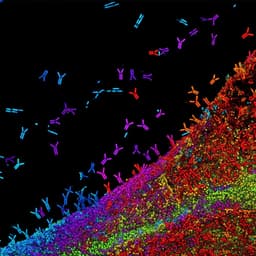
Interdisciplinary Studies
Collaboration in the time of COVID: a scientometric analysis of multidisciplinary SARS-CoV-2 research
E. Cunningham, B. Smyth, et al.
This research by Eoghan Cunningham, Barry Smyth, and Derek Greene delves into the collaboration dynamics of over 166,000 COVID-19 research articles, revealing insightful differences in team structures before and during the pandemic. Discover how this unprecedented global crisis has reshaped multidisciplinarity in research efforts!
~3 min • Beginner • English
Introduction
The scientific response to the SARS-CoV-2 pandemic has been unprecedented, with researchers from diverse and sometimes surprising fields (e.g., artificial intelligence, economics, particle physics) contributing to address clinical and societal challenges. By January 2021, more than 166,000 research papers related to SARS-CoV-2/COVID-19 had been identified by AI2 and WHO, highlighting a period of extraordinary scientific productivity. Collaboration and increasing team sizes are well-documented trends linked to higher research impact, and multidisciplinary science is often associated with particularly successful outcomes and is considered key to addressing complex global challenges. Multiple initiatives during COVID-19 promoted collaboration, open access to research, and data sharing, with international bodies advocating for international and multidisciplinary efforts. However, early studies suggest that COVID-19 research has been less internationally collaborative and has involved smaller teams compared with recent pre-pandemic work, potentially due to the coordination costs of multidisciplinary work combined with the urgency of the response. In this study, we evaluate the scale and nature of collaboration in COVID-19 research during 2020 using scientometric techniques across COVID and non-COVID publications before and during the pandemic. We use three measures: Collaboration Index (CI) to estimate collaboration levels; author multidisciplinarity to gauge cross-disciplinary publishing by individuals; and team multidisciplinarity to assess disciplinary diversity within research teams. We find a lower CI for COVID-related research compared to non-COVID trends, but higher author multidisciplinarity and more diverse teams in COVID-related work. These insights inform understanding of research dynamics under pandemic conditions and may guide future large-scale scientific initiatives; we also develop techniques to explore collaborative research that may be broadly useful.
Literature Review
Methodology
Datasets: The study builds on the COVID-19 Open Research Dataset (CORD-19), comprising >400,000 scholarly articles (150,000+ with full text) related to COVID-19, SARS-CoV-2, and related coronaviruses, sourced from PubMed, PubMed Central, bioRxiv, medRxiv, arXiv, and the WHO COVID-19 database. COVID-19-related research was defined by excluding articles prior to 2020 and selecting papers containing terms such as "COVID", "COVID-19", "Coronavirus", "2019-nCoV", "SARS-CoV", "MERS-CoV", "Severe Acute Respiratory Syndrome", or "Middle East Respiratory Syndrome", yielding 166,356 COVID-related research papers. Bibliographic metadata were supplemented using the Microsoft Academic Graph (MAG), particularly leveraging MAG Fields of Study (FoS) for topic/discipline categorization. MAG identifies a hierarchy of >700,000 topics; papers in the COVID set average 9 FoS with 65,427 unique fields represented. To create a more tractable taxonomy, each field was replaced by its parent and topics considered at two levels: 19 level-0 FoS (disciplines) and 292 level-1 FoS (sub-disciplines). Thus, each article is associated with multiple disciplines (e.g., Medicine, Physics, Engineering) and sub-disciplines (e.g., Virology, Particle Physics, Electronic Engineering) by traversing the FoS hierarchy. To contextualize author backgrounds, MAG metadata for additional articles authored by COVID-19 authors (post-2015) were included. The final dataset contains 5,389,445 papers, partitioned into: (1) 2020-COVID-related (166,356); (2) Pre-2020 non-COVID (2016–2019; 4,017,655); and (3) 2020-non-COVID (1,205,434). Notes: All non-COVID research articles included contain at least one author who also published COVID-related research; non-COVID research was collected for 299,046 COVID authors. Table 1 reports counts of authors, articles, and fields, and articles per year.
Collaboration Index (CI): The annual CI is defined as the ratio of the number of authors of co-authored articles to the total number of co-authored articles. Because CI is sensitive to corpus size, to facilitate fair comparisons the authors generate a CI distribution for each dataset by re-sampling 50,000 papers 1,000 times per year, without replacement, and computing CI for each sample.
Author multidisciplinarity: To quantify individual authors' multidisciplinarity, the study constructs an unweighted bipartite network linking authors to fields (FoS) based on publications. Projecting to a field-of-study network yields a dense weighted graph over the 292 level-1 sub-disciplines, where two fields are linked if at least one author has published in both; edge weights correspond to the number of such authors. Using the MAG FoS hierarchy, nodes are assigned to 19 overlapping communities (level-0 disciplines). Edges within a community reflect cross-publication within a discipline; edges between communities reflect cross-disciplinary publication (either within a single interdisciplinary paper or across separate publications). For each year, the authors compute the proportion of total edge weights that lie between communities. For 2020, they also compute this proportion after removing COVID-19 papers (2020-non-COVID) to isolate pandemic effects.
Research team disciplinary diversity: Team diversity is measured via authors' publication vectors across the 19 level-0 disciplines, where each vector component is the proportion of an author's publications in that discipline. Pairwise cosine similarities S_ij between authors' publication vectors are computed, and team similarity S_team is defined as the average of all pairwise similarities: S_team = [2/(p(p−1))] Σ_{i<j} S_ij, where p is team size. Team disciplinary diversity is reported as 1 − S_team. Authors without available prior research are excluded from similarity calculations (team size for normalization is adjusted accordingly). To avoid inflating similarity via the focal paper, publication vectors used for 2020 papers exclude 2020 outputs; vectors for 2019 comparisons exclude 2019–2020 outputs. Diversity is compared by team size across: 2020-COVID-related, 2020-non-COVID, and 2019 baselines, with statistical testing via independent t-tests.
Case studies/visualization of multidisciplinarity: To visualize how authors pivoted across fields, the authors construct directed networks where COVID-related articles contribute edges from pre-2020 sub-disciplines (author backgrounds) to COVID-era sub-disciplines (article topics). They visualize selected subsets (e.g., Virology, Computer Science, Materials Science, Development Economics) with flow diagrams showing the top 50 edges by weight, with color-coding by parent discipline and edge weights proportional to author counts publishing across the corresponding sub-discipline pairs.
Key Findings
- Collaboration Index (CI): CI shows a steady year-on-year increase for non-COVID research, indicating a trend toward larger teams. In contrast, COVID-19 research in 2020 has a substantially lower CI (~5.6), implying significantly smaller teams compared with non-COVID work by the same authors in 2020. This result is robust to different re-sampling sizes (n=10,000; n=50,000; n=100,000).
- Author multidisciplinarity: The proportion of cross-disciplinary (between-community) edges in the FoS network increases significantly each year, with the largest increase in 2020. When isolating 2020-non-COVID work, there is still a significant increase relative to 2019 across most disciplines, but including COVID-19 research yields a much greater increase. Despite comprising <20% of 2020 output, COVID-19 papers contribute disproportionately to the rise in cross-disciplinary publishing, with significant odds ratio effect sizes across nearly all disciplines (per Fisher's Exact tests, p<0.05).
- Team disciplinary diversity: COVID-19 research teams exhibit higher disciplinary diversity than equivalently sized teams from 2019 and from 2020-non-COVID research. Independent t-tests show that COVID-19 team diversity is significantly higher (p<0.01) across team sizes. Non-COVID 2020 teams also show increased diversity over 2019, but the increase is smaller than for COVID-19 teams.
- Team-size distribution and impact indicators: While 20% of COVID-19 papers have more than 8 authors and these account for over 60 of the 100 most cited coronavirus publications, the majority (53%) of COVID-19 papers have four or fewer authors, underscoring the prevalence of smaller teams.
Discussion
The findings indicate that, despite an overall trend toward larger, more collaborative teams in science, COVID-19 publications in 2020 involved significantly smaller teams. This may reflect the urgency and coordination costs associated with rapid pandemic response, and could potentially have implications for scientific impact given established links between larger teams and higher impact. Nonetheless, small teams can play a distinct, disruptive role in science by bridging disparate areas and amplifying promising, less-popular ideas. The study finds evidence consistent with increased connectivity between disciplines during COVID-19: author-level multidisciplinarity increased markedly and research teams were more diverse than comparable pre-pandemic and contemporaneous non-COVID teams. Non-COVID 2020 research also continued pre-existing trends toward greater collaboration and multidisciplinarity, but COVID-19 research exceeded these trends, suggesting a pandemic-driven acceleration of cross-disciplinary engagement. Visual case studies (e.g., Virology, Computer Science, Materials Science, Development Economics) highlight strong cross-disciplinary flows, such as machine learning researchers contributing to medical imaging tasks or cross-pollination among biology, chemistry, and medicine in virology-focused work. Overall, the results suggest that scientists favored smaller but more multidisciplinary teams to collaborate efficiently under pandemic constraints, increasing the cross-disciplinary connectivity of the research landscape.
Conclusion
This scientometric analysis shows that COVID-19 research in 2020 was characterized by smaller teams yet higher author multidisciplinarity and greater team disciplinary diversity compared with non-COVID research before and during the pandemic. The work introduces methods for measuring and visualizing collaboration and multidisciplinarity that can be applied to other domains, aiding researchers and funders in understanding and fostering cross-disciplinary collaboration. The findings support a view that, under urgent conditions, researchers formed smaller teams while broadening disciplinary participation to maintain problem-solving breadth. Future research could extend these analyses longitudinally to assess post-pandemic trends, examine international collaboration patterns in greater detail, and apply the visualization methodologies to other large-scale, multidisciplinary scientific efforts.
Limitations
Related Publications
Explore these studies to deepen your understanding of the subject.







